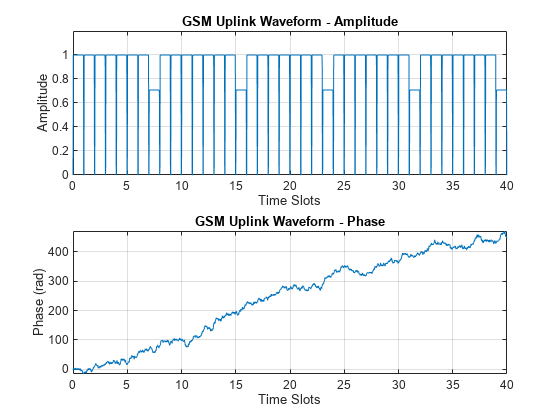gsmInfo
View GSM waveform information
Description
infostruct= gsmInfo(gsmCfg)
Examples
View information from downlink and uplink GSM configuration objects.
Create a GSM downlink configuration object with default settings and use gsmInfo to view the waveform information structure.
cfgDL = gsmDownlinkConfig; infostructDL = gsmInfo(cfgDL)
infostructDL = struct with fields:
SymbolRate: 2.7083e+05
SampleRate: 4.3333e+06
BandwidthTimeProduct: 0.3000
BurstLengthInSymbols: 156.2500
NumBurstsPerFrame: 8
BurstLengthInSamples: 2500
FrameLengthInSamples: 20000
Create a GSM uplink configuration object with default settings and use gsmInfo to view the waveform information structure.
cfgUL = gsmUplinkConfig; infostructUL = gsmInfo(cfgUL)
infostructUL = struct with fields:
SymbolRate: 2.7083e+05
SampleRate: 4.3333e+06
BandwidthTimeProduct: 0.3000
BurstLengthInSymbols: 156.2500
NumBurstsPerFrame: 8
BurstLengthInSamples: 2500
FrameLengthInSamples: 20000
Create a GSM downlink TDMA frame configuration object with default settings, and then create a GSM waveform containing five TDMA frames. GSM TDMA frames have eight time slots, each separated by a guard period of 8.25 symbols or about 30.46x10e-3 ms. Plot the GSM waveform.
Create a GSM uplink TDMA frame configuration object, specifying 3 dB of attenuation in the last time slot to help identify the end of each frame.
cfggsmul = gsmUplinkConfig('Attenuation',[0 0 0 0 0 0 0 3])cfggsmul =
gsmUplinkConfig with properties:
BurstType: [NB NB NB NB NB NB NB NB]
SamplesPerSymbol: 16
TSC: [0 1 2 3 4 5 6 7]
Attenuation: [0 0 0 0 0 0 0 3]
PulseLength: 4
RiseTime: 2
RiseDelay: 0
FallTime: 2
FallDelay: 0
Display information about the configured gsmUplinkConfig object by using the gsmInfo function. Assign the frame length in samples to a variable, spf, for use in computing the plot timescale.
wfInfo = gsmInfo(cfggsmul)
wfInfo = struct with fields:
SymbolRate: 2.7083e+05
SampleRate: 4.3333e+06
BandwidthTimeProduct: 0.3000
BurstLengthInSymbols: 156.2500
NumBurstsPerFrame: 8
BurstLengthInSamples: 2500
FrameLengthInSamples: 20000
spf = wfInfo.FrameLengthInSamples;
Create the GSM waveform by using the gsmFrame function, and then plot the GSM waveform. The last time slot of each frame is 3 dB less than the other time slots in that frame.
numFrames = 5; waveform = gsmFrame(cfggsmul,numFrames); t = 8*(0:length(waveform)-1)/spf; numTS = 8*numFrames; subplot(2,1,1) plot(t,abs(waveform)) grid on axis([0 numTS 0 1.2]) title('GSM Uplink Waveform - Amplitude') xlabel('Time Slots') ylabel('Amplitude') subplot(2,1,2) plot(t,unwrap(angle(waveform))) grid on title('GSM Uplink Waveform - Phase') xlabel('Time Slots') ylabel('Phase (rad)')

Input Arguments
GSM configuration, specified as a gsmUplinkConfig
or gsmDownlinkConfig object.
Output Arguments
Structure containing these fields with information about the characteristic GSM waveform based on the input configuration object.
GSM symbol rate in symbols per second, returned as a positive integer.
GSM sample rate in samples per second, returned as a positive integer.
Product of bandwidth and symbol time of Gaussian pulse for the GMSK modulator, returned as a positive integer.
GSM burst length in symbols, returned as a positive scalar.
Number of bursts in a GSM TDMA frame, returned as a positive integer.
GSM burst length in samples, returned as a positive integer.
GSM frame length in samples, returned as a positive integer.
Extended Capabilities
C/C++ Code Generation
Generate C and C++ code using MATLAB® Coder™.
Version History
Introduced in R2019b
See Also
Objects
Functions
MATLAB Command
You clicked a link that corresponds to this MATLAB command:
Run the command by entering it in the MATLAB Command Window. Web browsers do not support MATLAB commands.
Seleziona un sito web
Seleziona un sito web per visualizzare contenuto tradotto dove disponibile e vedere eventi e offerte locali. In base alla tua area geografica, ti consigliamo di selezionare: .
Puoi anche selezionare un sito web dal seguente elenco:
Come ottenere le migliori prestazioni del sito
Per ottenere le migliori prestazioni del sito, seleziona il sito cinese (in cinese o in inglese). I siti MathWorks per gli altri paesi non sono ottimizzati per essere visitati dalla tua area geografica.
Americhe
- América Latina (Español)
- Canada (English)
- United States (English)
Europa
- Belgium (English)
- Denmark (English)
- Deutschland (Deutsch)
- España (Español)
- Finland (English)
- France (Français)
- Ireland (English)
- Italia (Italiano)
- Luxembourg (English)
- Netherlands (English)
- Norway (English)
- Österreich (Deutsch)
- Portugal (English)
- Sweden (English)
- Switzerland
- United Kingdom (English)